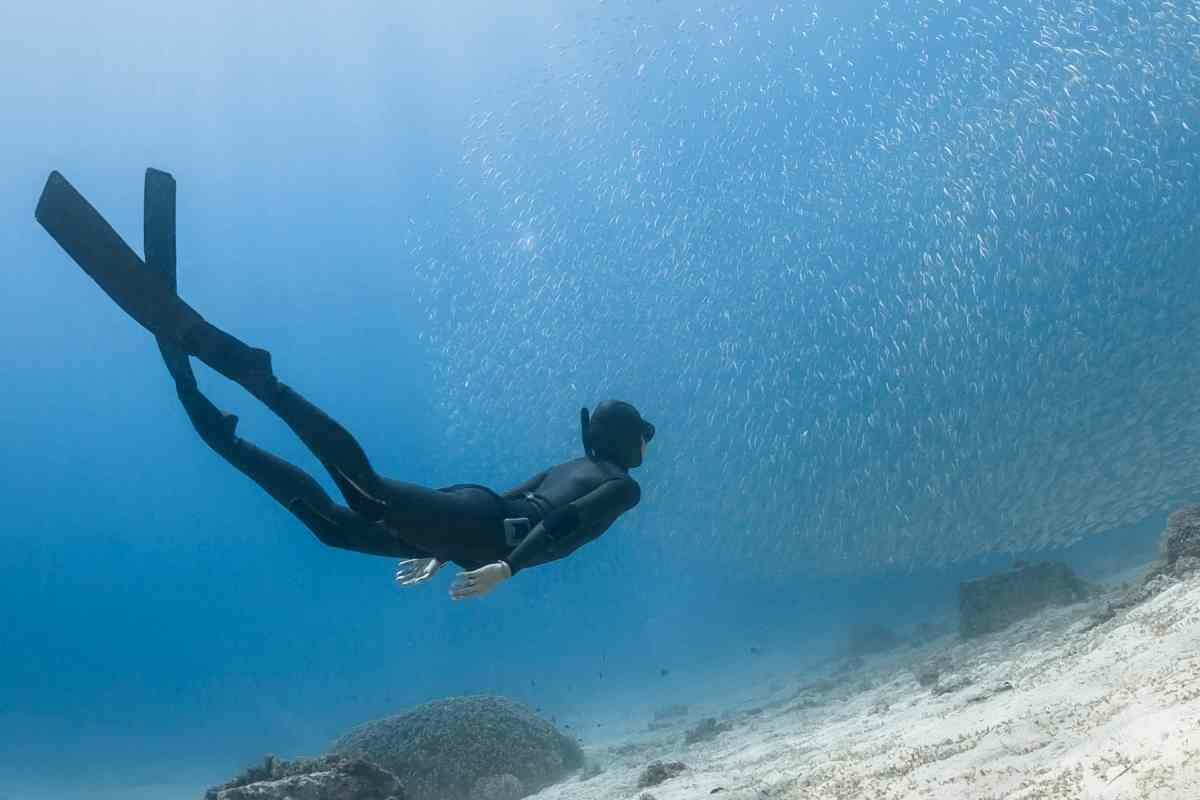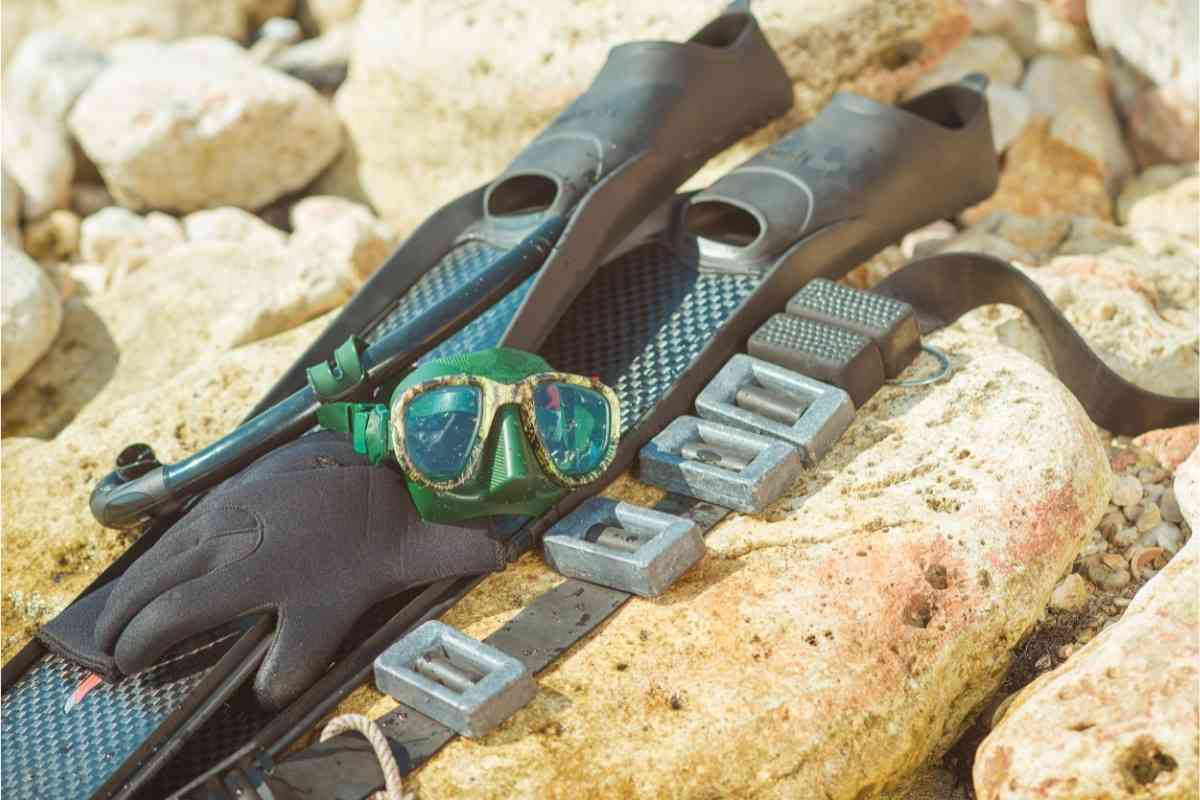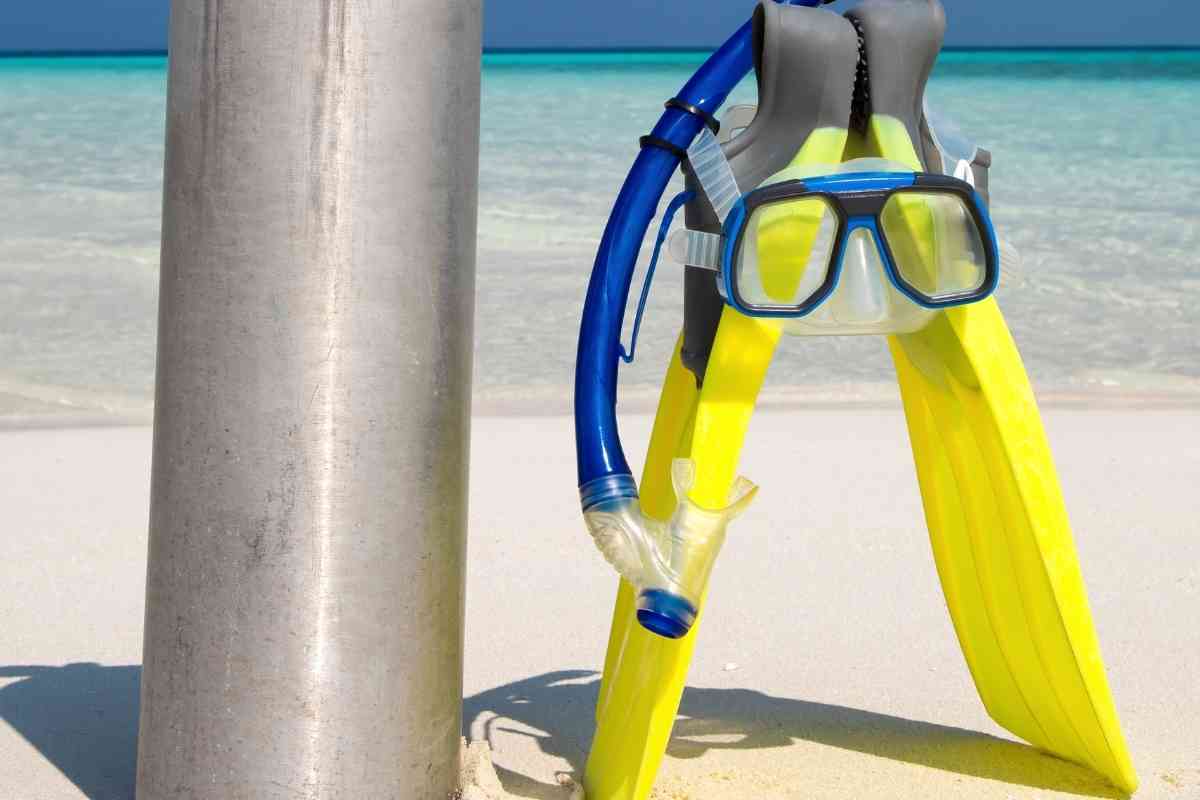Freediving is a form of unassisted diving that requires you to hold your breath until you resurface. Without using any breathing apparatus, freedivers can hold their breath underwater for longer than most people. An average human, without any prior training, can hold their breath for just about thirty seconds, while most freedivers can stay underwater for ten minutes or more.
Breathing techniques and lung training are necessary to help freedivers stay longer underwater. This requires greater lung capacity and breathing control. Training can help conserve valuable oxygen and more oxygen means being able to dive deeper for longer.
If you look at freedivers, you’ll notice that they use longer fins than those used for snorkeling or scuba diving. But why do freedivers use long fins?
Unlike short fins used for scuba diving, freedivers use longer fins that can displace more water per kick, helping propel them through the water more rapidly.

Why Freedivers Use Long Fins
Efficiency
Freedivers use long fins because the longer the fin’s blade, the more water is displaced per kick. This requires less physical effort to move, resulting in more oxygen being preserved within the body for longer durations underwater. Even though freediving blades require a considerable amount of kicking thrust, you still use less energy because the distance covered with each thrust is greater than it would be without them.
Standard long freediving blades are about 80 cm to 98 cm long and are made from rubber, plastic, carbon fiber, or some combination of these materials. Long fins are preferable because more potential power is unlocked with each kick, giving the freediver more underwater thrust. This leads to a faster dive and a longer underwater duration.
Ease Of Use
In strong currents, longer blades are preferred over shorter blades. By displacing more water with each kick, they provide a greater amount of thrust to fight against the current, thereby allowing divers to plunge deeper and have greater control underwater.
If shorter fins (such as scuba fins) are used, more energy is wasted, and the freediver might not reach the desired depth they would normally reach with longer blades.
Flexible long fins are better for divers who do not need to fight strong currents, while stiffer blades are used by divers who deal with strong currents, since strong currents require fins that can deal with the additional stress that comes with the greater water pressure.
Long carbon blades are much more reliable and resilient than blades made with other materials like fiberglass or plastic.
Even though long fins made of fiberglass are less resilient than those made with carbon, they are still more responsive and last longer than blades made out of plastic. Long fins made with fiberglass are more suitable in rocky environments and are often used in reef-like locations due to their incredible durability and impact-resistant construction.
Easier To Navigate
Long fins also prove more useful in emergencies since they help freedivers get to the surface faster. When using a shorter type of fin, the freediver can tire quickly and they might blackout before returning to the water’s surface. This can be dangerous, especially if there is no one around to notice them and get them out of the water quick enough.
When freediving more than 10 meters deep, the body experiences negative buoyancy–in practice, this feels like the ocean is pulling you in deeper. Therefore, it requires more muscle power from the freediver to get back up to the water’s surface. That’s where longer fins come in handy.
Long fins provide enough propelling force to push the body upward, diverting more water per kick. People with weak leg muscles may struggle at first when using long freediving fins, but over time will get used to it, and their leg muscles will grow and become stronger to accommodate the length of the fins.
What Do Fins Do When You Freedive?
People move through the water by displacing water with each kick. Freediving fins have a larger surface area, which help displace more water and offer more power to the diver. The long blades of freediving fins make a flapping motion in the water, which provides the diver with an extra boost of power.

Components of Freediving Fins
The components that makeup freediving fins are:
Foot Pockets
Foot pockets can either be integrated into the freediving blades or feature separately from them. Separated blades and foot pockets are usually fastened together with either screws or clips on the side, while others have to be glued to the blades. Glued pockets are usually less durable and will eventually wear out.
Rails and Angle
The rails are the frames that surround your fin and give rigidity to the entire structure.
Thicker rails make the fin blades more rigid. Likewise, soft rails will not adequately support the fin blades, leading to breakage due to too much stress on the blade itself.
Angled fin blades make swimming on the water surface much easier than non-angled fin blades.
Blade
The blades are the most prominent part of the fins. They are flat extensions with a wide surface area. The blade’s length determines whether a fin is long or short.
Channels
The channels are the vein-like structures that run along the surface of the fins. The design of the channels can vary with the make of the fins, and some are more prominent than others. While sometimes a design feature, they also provide support and help with fluid dynamics.
Socks
Socks are very valuable to your foot pockets by keeping your feet warm in cold waters. The thickness of the socks should be noted when considering the size of your fins.
Additionally, foot pockets are designed to be comfortable and to enhance the diver’s control, complimenting the movements of the diver.
Freediving Fins vs. Scuba Fins
Scuba Fins
Many people wonder what the difference is between freediving fins and scuba fins. The main difference that distinguishes the scuba fin from the freediving fin is the length.
Scuba fins usually have an available length of 25 inches to 30 inches, while most freediving fins exceed 30 inches in length.
Another major difference is weight. Scuba divers carry more equipment than freedivers and therefore need lighter fins. By contrast, freedivers need no equipment and can handle the extra weight of their longer fins.
Scuba fins come with an open heel or full foot pocket and are excellent for controlling one’s movements efficiently.
Furthermore, fins made for scuba diving usually have stiffer blades which allow for short bursts of underwater propulsion.
While scuba fins still require a decent amount of leg muscle, they require less strength and endurance than freediving fins.

Freediving Fins
Due to the absence of breathing equipment, freedivers require long, streamlined fins to move through the water quickly and efficiently.
The length of the freediving fin gives it a natural advantage over scuba fins when it comes to the depth and speed of the divers.
Freedivers have to get as deep as possible and return to the surface as quickly as possible, all in one breath. Because freedivers rely on their fins so heavily, the equipment made for freediving is typically made of higher quality than that of scuba diving to ensure easy and quick movement through the water.
What Fins Are Best for Freediving?
There are several brands and designs of fins on the market, and it can be difficult finding one that satisfies your needs. No need to worry about it–we tested a number of different long fins on the market and have landed on our all-time favorite brand.
Spearfishing | Gara Professional LD Fin

The first thing we want to point out is the material used to make the Gara Professional LD fin. It is made with elastomer polypropylene.
Elastomer polypropylene is a polymer consisting of different plastic components, which combine to make this an effective and resilient fin that performs reliably.
First of all, the material is very durable, which is especially important when it comes to diving fins. You can use the fin for a long time, even under harsh conditions. It allows you to swim against a strong current without worrying about your fin getting damaged.
The last thing you want is your fin breaking or tearing when you’re deep underwater. Thankfully, such damage is unlikely with this well-made product.
The material used to make the fin is also very lightweight while being robust and stiff enough to push against the water. With the elastomer material, you have a fin that is light and easy to move, which means you won’t have to stress your leg muscles too much with each stroke. Likewise, the fin is rigid enough to displace water, allowing you to build momentum with the smallest of movements.
Notably, the fins are designed so the blades and foot pockets are perfectly aligned. This design contributes to the fin’s efficiency, helping you achieve more with minimal effort. You can swim long distances without exerting yourself too much.
Another advantage is the full-footed foot pocket design. The full-foot design means it is especially comfortable for you to wear for long periods of time underwater. The fins’ feet completely cover your heels, making sure they stay securely attached to your feet.
This prevents the fins from slipping off your feet when in the water. While incredibly secure, you can still pull them off with ease and don’t need to wear socks while wearing them.
These fins have dimensions of 30 x 8 x 4 inches and weigh approximately 1.86 kg. The length of the fins enhances your performance in the water, and you can swim fast and deep with slight strokes.
Overall, the design of this product is optimized for your movement and convenience. If you’re looking for a new long fine to free-dive with, this product could be the best choice for you.
Pros
- The material is lightweight and rigid
- It is comfortable
- It has a full-foot design
- It comes with a 2-year warranty
Cons
- The sizing chart is not always accurate
If you need long fins for freediving, the Cressi Gara Professional LD diving fins are a great choice that many professionals trust.
Different Materials Used to Make Freediving Fins
The materials used in making the fins can affect how they function. Don’t just assume that all long fins are the same. Here we’ll show you the three major types of fins available and the materials used to produce them.
The Plastic Freediving Fins
The plastic freediving fin is one of the most common fins. As the name suggests, the blades are composed of very durable plastic. You can pick up plastic fins from almost any scuba store.
When diving, these fins propel you according to Newton’s third law of motion, which states that “every action has an equal and opposite reaction.” When you kick out, the fin bends and then snaps back into place. By doing so, a force proportional to your movement is generated, driving you forward.
However, the amount of force generated is dependent on how hard the blade snaps back into position. In the case of the plastic fins, the blades snap back into position weakly and generate very little force compared with other materials.
As a result, the rate of propulsion when using the plastic fin is low, and you will need to apply more effort when trying to swim into deeper water. Of course, more effort means you will use more energy and get tired more easily.
On the bright side, the plastic fins are the cheapest, which is why they are easy to find. Also, plastic freediving fins are a great choice for beginners because they will prevent you from accidentally diving deeper than you wanted to.
Fiberglass Freediving Fins
Fins made of fiberglass are the next best thing after plastic fins. Fiberglass fins have a higher responsiveness compared to plastic fins. What we mean is, when you kick out with a fiberglass fin, it bends and snaps back to its original position faster than a plastic fin.
The ability of the fin to snap back quickly generates more force than the plastic fin, propelling you further. With the fiberglass fin, you can cover more distance with less movement when compared to plastic fins.
Of course, there is a catch. Fiberglass fins are more expensive than plastic fins and are less common. Fiberglass fins are perfect for intermediate or semi-professional freedivers.
Carbon Fiber Freediving Fins
Carbon fiber fins are the best of freediving fins, and they are the first choice for many professional freedivers.
Carbon fiber is a highly flexible material with high elasticity. When carbon fiber is displaced or moved, it will snap back into its original position faster than plastic or fiberglass. While these function according to the same basic mechanic as the first two materials, they do so more reliably and require less effort.
For this reason, carbon fiber fins generate more energy, propelling you further than fiberglass fins. If you want to go freediving in the deeper parts of the water and minimize energy loss, carbon fiber fins are a great choice for you.
However, carbon fiber fins are the most expensive on the market and are not as common as plastic or fiberglass fins. Also, we won’t advise you to start training with this type of fin because they are harder to control, and any small movement can take you farther away from the surface than you intend to go. These fins are not recommended for beginners.
Are Longer Fins Better?
The type of fin you’ll want to use (long or short) will depend on the type of diving you’re doing. If you’re scuba diving in shallow waters, a shortfin is sufficient.
However, if you’re freediving, a long fin is the best choice, since the blades have more surface area and can displace a larger amount of water. For this reason, long fins allow you to dive with ease and go deeper without expending too much energy.
Furthermore, long fins allow you to swim faster–this is especially important when you don’t have any air support such as scuba gear. If you need to resurface quickly for a breath of fresh air, long fins can speed up your resurface speed, helping you escape danger.
Conclusion
Freediving is an art and requires a certain amount of skill and courage to pursue. Unassisted, freedivers head into deep waters with just their swimming skills, fins, and sometimes a snorkel.
So, why do freedivers use long fins? The answer lies in the convenience of the longer fins. Freedivers with long fins can cover more distance while conserving energy at the same time. As you can tell, there is a lot to learn about the sea and the different kinds of equipment used to explore it. Check out other articles of ours to find out more.
